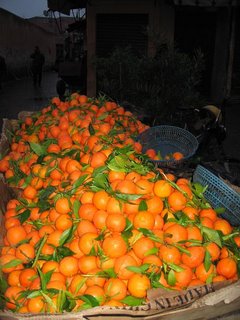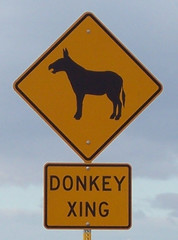Map Key - Orange:Tiznit, Morocco-Dakhla, Western Sahara by bus, Green:Dakhla-Nouadhibou, Mauritania by private chauffeur, Blue:Nouadhibou-Choum by freight train, Pink:Choum-Atar by pick-up truck crammed with sixteen people and a goat.
We had an epic journey ahead of us, from Tafroute in the Anti-Atlas region of Morocco to Atar, a Saharan town in northern Mauritania. The journey would involve crossing Western Sahara, the disputed territory between Morocco and Mauritania. We expected to spend several days traveling in various modes of transport on this trans-Saharan adventure.
Our planned route was Tafroute to Tiznit by bus (3 hours); Tiznit to Dakhla by bus (18 hours); Dakhla to Nouadhibou, including the border crossing into Mauritania, by any means of transport available since there is no public transport on this route (duration unknown); Nouadhibou to Choum by freight train (12 hours); Choum to Atar by bush taxi (3 hours).
Our night bus to Dakhla arrived an hour late, and full. We took the only two seats left, and crammed ourselves on the back row above the engine. We slowly started to cook in the hottest place on an already steamy, non-air conditioned bus - the perfect start to an 18 hour journey through the desert. Throughout the night, the bus stopped in towns we neither knew nor cared about, still hundreds of miles from Dakhla. I did make friends with a woman traveling with her young son. There was no conversation beyond grumbling about the heat on the bus, but we exchanged several smiles, which doesn’t happen often in this non-smiling culture, as well as some biscuits and apples. Sharing food is indeed a universal gesture of friendship. Once we entered the disputed territory of Western Sahara, we were stopped at police checkpoints every so often. The police wrote down our passport details and professions at each checkpoint while the bus waited. Being the only foreigners on board (and thus the only ones obliged to cooperate and produce passports), we kept the entire bus waiting several times. The passengers and drivers were very gracious, and the police charming. No ‘fees’ or bribes expected.

We also found a barber empty of male clients who said he could transform my helmet hairdo into something normal looking. The result was a very short, slightly manly cut, but thankfully the helmet was gone, along with Jason’s tedious bad hair jokes.

Our privately chauffeured Mazda during a tea break in Western Sahara.
We asked several locals around town about transport to Mauritania. We were pointed toward a bloke named Hassane who told us to wait in the morning outside the Hotel Sahara, assuring us that freelance drivers would be waiting there. We took his advice, and didn’t wait long the next day before a ‘driver’ came along – a personable guy whose knock-off Ray Bans and Adidas tracksuit made him look more like a dodgy geezer than a private chauffeur. However, he had a decent looking Mazda sedan, and seemed genuine. A deal was struck, and we jumped in before he changed his mind about the price or filled the car with other passengers. 600 dirham seemed like a good price for a private ride all the way to Nouadhibou, Mauritania, border crossing and all.

We took a long lunch break, since Saad said the Moroccan border post was closed for lunch until three. Upon arrival at the border, we found a bunch of cars from the Plymouth-Banjul rally, whose drivers looked well cooked from their long wait in the sun, evidently oblivious to the dining schedule of the police and customs officials. Saad pulled up in front of all of them and proceeded to greet everyone at the border like long lost friends. He went through the whole greeting ritual - “Salaam! Ca va? La bas? Hemdullah! La bas? Ca va? Blah blah…” which is automatic and simultaneous between Moroccan men, then chatted for a good ten minutes with each. He knew everyone. Apparently we had hired a pro – much better than hitching with rally drivers or a camper van, options we had considered. It was hard to know who was processing what or even who worked at the border post, and it looked like the British rally drivers could be there all afternoon in a nice orderly queue. We cleared customs, which involved Saad chatting with his mates in the customs office for a bit, then we breezed through the police checkpoint (another few minutes of chat) before entering the unpaved road into the place where disputed Western Sahara (supposedly Moroccan territory) and Mauritania meet.
This was truly a "no man’s land", strewn with litter and shells of blown up cars – disturbing signs that the area was full of landmines, as we’d expected. We wove around the rocky road, gob smacked by the car shells and feeling glad, once again, that Saad knew what he was doing, since there were plenty of side roads to easily confuse a novice. Shortly after what looked like a car park (actually a holding lot for cars confiscated by customs), Saad pulled over. He nonchalantly sauntered into the mine field and started digging with his hands. He pulled out a pair of Moroccan license plates, and quickly buried his Mauritanian plates in their place. This would make things easier with customs, he explained. Clearly Saad had done this a thousand times before. But burying plates in a live minefield? It took us a while to get our heads around that one.

Mauritania seemed as inviting as Oz as we navigated the "no man's land", and as we progressed, Saad pointed out a shiny camper van shell. A French couple had apparently taken a wrong turn the previous week, and got themselves blown up. The Mauritanian border police were a welcome sight in their rolled up pants and flip flops, signaling a safe arrival to a new country. A ten minute chat with Saad ensued, then we were moved along to the customs office – a shack with flattened cardboard boxes for a ceiling and plastic tablecloths lining the walls. The officials were friendly and kindly advised that we shouldn’t wait too long to have children. I laughed, and said maybe we’d have children with us the next time we passed through.
Entering Nouadhibou was a far cry from finding Oz, but was definitely an arrival in a different world. We drove by yards full of scrap Renaults, being patched up to go back on the road, old Mercedes rammed to the gills with people and cargo, dubious looking butcher shops with meat barely visible for the flies, haphazard traffic and a mix of black and brown skin. Saad had Mauritanian music playing in the Mazda for a completely authentic feel. He took us to our chosen campsite and negotiated for our room. We tipped him well and said our farewells to our Moroccan chauffeur and friend.
We had afternoon tea Mauritanian style with the other campsite guests - a couple of guys from the Plymouth-Banjul rally, some French aid workers and a handful of others, including Tony and Maureen Wheeler, founders of Lonely Planet guidebooks. The next morning we scoped out the departure time of the freight train to Choum. We’d heard that the train made a daily return trip to the desert after dropping its load of iron ore at the port in Nouadhibou. We were told to come back before the 3p.m. departure time.

Our "too cool" local taxi driver pauses for a photo in front of the Nouadhibou train station.
Arriving two hours early, determined to get seats in the solitary passenger car, we got situated in the train station – a concrete shed by the track. With fly infested litter strewn around, peeling paint and graffiti, this was a no frills train station. We were glad of its concrete benches though – an excellent, shady vantage point for taking in the interesting social scene that unfolded. The refreshments vendors – three women with a table and chair each and boxes and buckets full of stuff – were the first to arrive. They unpacked and displayed their wares: cigarettes, sweets, biscuits, gum, water, soda, tissues, sardines, gas canisters, matches, hard boiled eggs, fruit, flashlights and batteries, and anything and everything a person might need on a long train ride through the desert. Clearly this was a daily ritual for these self-appointed service providers. A snoozing Mauritanian woke up and informed us that a man with a briefcase would arrive later to sell tickets. He also likened boarding the train to war. Good thing we arrived early. By this time, people were assembling by the tracks in the sun, with their boxes, large suitcases, buckets and bags of cargo, positioning themselves ready for the onslaught. We watched many cartloads of cargo being hauled to the track by groups of men and their tired donkeys, clearly strained by the hot, ambitious task.

We wondered if we might have been better off riding in an empty cargo container, like many of the locals. Jason wasn’t ready to resign himself to standing in the hallway for the next 12 hours, and suggested we approach the man seated alone in a six berth cabin rammed with boxes, buckets and coolers. I was skeptical, but with nothing to lose, approached the traditionally clad Mauritanian man in his blue robes embroidered in gold. I waited for the ‘no’, but instead he asked if there were just the two of us. We were in! We threw our packs up on the rails and helped our new friend pile up the cargo to clear two seats. “Seats” is a generous term for what would have been seats when this train car was built about a hundred years ago. Now, they are seat frames with the odd spring and no cushions, although there were a few foam pads lying around that would soften the ride. We could feel the springs pressing through the foam, and the window to our right was shattered. The light fittings and bulbs had long since been removed and everything was caked in thick Saharan dust. It is hard to believe this car is still in daily use, even in Africa. Our berth was next to the stinky toilet, which was in as poor a state of repair as the rest of the carriage. Truly, the place was foul. In spite of all this, we were delighted to have secured ‘seats’ for the 12 hour ride to Choum.

The train set off with a jolt, and we were on our way, east bound on what is supposedly the longest train in the world. Leaving Nouadhibou, we stood by the window to take in the desert view. It was marred by mountains of rubbish. The unsightly, unnatural litter landscape went on for miles, with thin plastic bags fluttering in the wind like ugly weeds that will never die. Those things (that we all use on a daily basis) are truly evil. It was a depressing sight. I wished we weren’t seeing this, just like I wished the passengers wouldn’t routinely chuck their used bottles, cans and cigarette packets out of the train windows. In the West, we might pay to hide our waste from view, but our plastic bags don’t decompose any faster than these.
Eventually the rubbishscape ended, and we were out in the wilderness: just the train, the desert and us. I stood by the open window gazing out for miles, knowing after sunset there would be nothing to see. It wasn’t long before my face, clothes and lungs were filled with dust. Headscarves and ‘howlis’ (cotton head cloths for men) worn by all the locals clearly serve a purpose. Unfortunately we had neither. The other two occupants of our car appeared, and busily started brewing up Mauritanian tea using filthy equipment. We had found ourselves sharing a berth with the train’s refreshments vendor, which meant a steady stream of customers coming by for a tea (or three). Assisted by young Mohammed, Jamal the tea guru was up and down the train with his tea tray constantly. Each pot brewed involved a long process of pouring the tea from glass to glass numerous times until frothy on top and well mixed. It was amazing to watch Jamal at work, pouring from glass to glass on this bumpy train, never spilling, not even when the train screeched and jammed to an abrupt halt. He had been doing this for twelve years, and in spite of his grimy tools and supplies, he was a professional. He was also friendly and caring, finding us blankets, extra bits of foam, and giving us regular updates on how far along our 460 kilometer train ride we were. The smell of Jamal’s cigarettes provided occasional relief from the increasingly stinky toilet. I decided early in the journey I would not need the bathroom until we got to Choum. Jason somehow braved the stench three times.
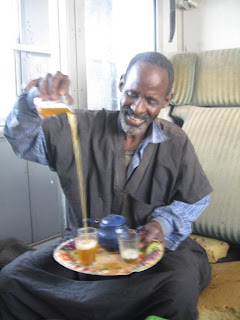
Jamal, the train's unofficial refreshment vendor, shows his skills during the unpredictably bumpy ride.
At sunset, the hallways filled with the faithful, finding a spot on the floor to pray. Their praying was a soft and soothing contrast to the noisy rhythm of train on track. It is hard not to be touched by the discipline of prayer here. Jamal rigged up a candle in a plastic bottle so we had light. By the time we settled down to sleep, we’d made friends with the tea guys, Sidi Mohammed, our original berth-mate, Ahmed, who promised to help us find transport to Atar from Choum, and an unknown stranger who kindly gave Jason a piece of his ‘howli’ to protect him from the dust. It was impossible to get anything close to comfortable, but Jason got quite well situated and managed to sleep, while I developed a technique of sitting one bottom check on a certain spring until it was really sore, then shifting so the spring pressed somewhere else for a bit. It was just about workable. The last hour of the ride seemed to take forever. We were glad we were not continuing to Zouerat, another five hours away.
At Choum, we wove our way through motionless, blanketed bodies in the hallway and jumped down onto solid, sandy ground. Pickup trucks were waiting and we jumped on one along with Ahmed, a large number of other people and their cargo, which included a goat. Nothing was properly packed, especially the goat, and the prospect of a three hour ride to Atar like this was not fun. Thankfully we only rode a few hundred meters to a clearing where the vehicle was fully unloaded and we were told to wait while the driver prepared for the journey. We were tired and filthy, but thankful for the break from the discomforts of the iron ore train, and enjoyed the bright stars for an hour while we waited. In spite of a decent packing job, the back of the truck remained bumpy, lumpy and cramped when we piled back on. Everyone helped each other get situated with a lot of give and take as we shuffled for a tolerable spot. Tiredness dumbed our senses to the discomfort. By 3.30 a.m. the pickup was fully loaded and ready to go with seven adults, one baby and a goat inside, and eight adults in back. As the only female in back, surrounded by young men in pitch darkness, I was grateful to be in a Muslim country, knowing I would not be touched.
As we rode through the night on the rocky dirt track, we agreed this would be a Valentine’s Day to remember. We held hands all the way to Atar, partly because there was nothing else for me to hold on to and I was scared of flying out, and partly as man and wife almost at the end of an epic journey. We gazed at the trillions of stars unobscured by clouds, pollution or lights, in the middle of nowhere. We thought sharing the front seat of our Mercedes taxi in Nouadhibou might have been our most intimate moment for the day, but being joined by our hands as we were when we exchanged vows trumped the intimacy of the taxi.

Showered, fed and wearing fresh clothes, we were ready to explore the Sahara desert.
At day break we pulled into a deserted parking lot in Atar. We were greeted and offered assistance by all the locals we met as we stumbled towards the center of town. We found a restaurant and sat down, desperate for food. The friendly owner produced two fabulous omelets with chips and some artificial tasting juice just in time to rescue us from exhausted and hungry collapse. We had chosen accommodation outside of town which turned out to be a great decision. We were the only guests at the peaceful, chilled out camp in the desert, and soon crashed in a comfy stone hut. Sahara crossing accomplished.



 With a striking white mosque, and mud homes built into the side of the mountains, Oumesnat was the first Berber village we visited during our hike. What started as an incredibly dreary day began to look a bit brighter once we entered the village.
With a striking white mosque, and mud homes built into the side of the mountains, Oumesnat was the first Berber village we visited during our hike. What started as an incredibly dreary day began to look a bit brighter once we entered the village. 
 A kid, kid and another kid: we were enthusiastically followed by this young barefoot boy as he flung his goats from their limbs in a playful manner.
A kid, kid and another kid: we were enthusiastically followed by this young barefoot boy as he flung his goats from their limbs in a playful manner.
 Descending the final pass, Rachel is ready for a cold drink and a good stretch once we return to the hotel.
Descending the final pass, Rachel is ready for a cold drink and a good stretch once we return to the hotel. The view from our hotel's rooftop terrace at dusk.
The view from our hotel's rooftop terrace at dusk. 








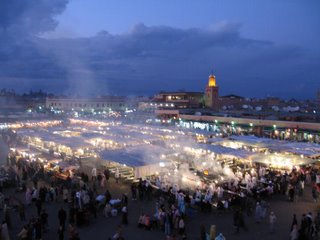 A view overlooking the Djemaa el-Fna at dusk.
A view overlooking the Djemaa el-Fna at dusk.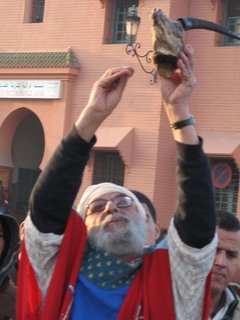







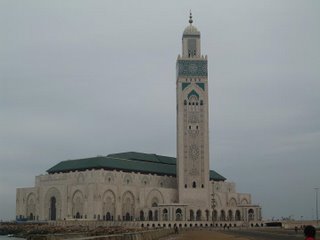 The Hassan II Mosque: Atlantic Ocean, Casablanca
The Hassan II Mosque: Atlantic Ocean, Casablanca
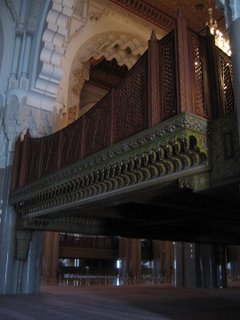

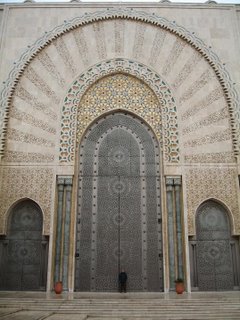
 1) A day with an official guide in Fez, including tip. The tour will involve exploring some far corners of the medina, and probably a visit to a Moroccan carpet shop - not necessarily a bad thing as carpet sellers always offer complimentary cups of tea!
1) A day with an official guide in Fez, including tip. The tour will involve exploring some far corners of the medina, and probably a visit to a Moroccan carpet shop - not necessarily a bad thing as carpet sellers always offer complimentary cups of tea!

